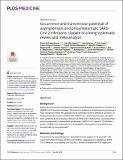Occurrence and transmission potential of asymptomatic and presymptomatic SARS-CoV-2 infections : update of a living systematic review and meta-analysis
Abstract
Background : Debate about the level of asymptomatic Severe Acute Respiratory Syndrome Coronavirus 2 (SARS-CoV-2) infection continues. The amount of evidence is increasing and study designs have changed over time. We updated a living systematic review to address 3 questions: (1) Among people who become infected with SARS-CoV-2, what proportion does not experience symptoms at all during their infection? (2) What is the infectiousness of asymptomatic and presymptomatic, compared with symptomatic, SARS-CoV-2 infection? (3) What proportion of SARS-CoV-2 transmission in a population is accounted for by people who are asymptomatic or presymptomatic? Methods and findings : The protocol was first published on 1 April 2020 and last updated on 18 June 2021. We searched PubMed, Embase, bioRxiv, and medRxiv, aggregated in a database of SARS-CoV-2 literature, most recently on 6 July 2021. Studies of people with PCR-diagnosed SARS-CoV-2, which documented symptom status at the beginning and end of follow-up, or mathematical modelling studies were included. Studies restricted to people already diagnosed, of single individuals or families, or without sufficient follow-up were excluded. One reviewer extracted data and a second verified the extraction, with disagreement resolved by discussion or a third reviewer. Risk of bias in empirical studies was assessed with a bespoke checklist and modelling studies with a published checklist. All data syntheses were done using random effects models. Review question (1): We included 130 studies. Heterogeneity was high so we did not estimate a mean proportion of asymptomatic infections overall (interquartile range (IQR) 14% to 50%, prediction interval 2% to 90%), or in 84 studies based on screening of defined populations (IQR 20% to 65%, prediction interval 4% to 94%). In 46 studies based on contact or outbreak investigations, the summary proportion asymptomatic was 19% (95% confidence interval (CI) 15% to 25%, prediction interval 2% to 70%). (2) The secondary attack rate in contacts of people with asymptomatic infection compared with symptomatic infection was 0.32 (95% CI 0.16 to 0.64, prediction interval 0.11 to 0.95, 8 studies). (3) In 13 modelling studies fit to data, the proportion of all SARS-CoV-2 transmission from presymptomatic individuals was higher than from asymptomatic individuals. Limitations of the evidence include high heterogeneity and high risks of selection and information bias in studies that were not designed to measure persistently asymptomatic infection, and limited information about variants of concern or in people who have been vaccinated. Conclusions : Based on studies published up to July 2021, most SARS-CoV-2 infections were not persistently asymptomatic, and asymptomatic infections were less infectious than symptomatic infections. Summary estimates from meta-analysis may be misleading when variability between studies is extreme and prediction intervals should be presented. Future studies should determine the asymptomatic proportion of SARS-CoV-2 infections caused by variants of concern and in people with immunity following vaccination or previous infection. Without prospective longitudinal studies with methods that minimise selection and measurement biases, further updates with the study types included in this living systematic review are unlikely to be able to provide a reliable summary estimate of the proportion of asymptomatic infections caused by SARS-CoV-2. Review protocol : Open Science Framework (https://osf.io/9ewys/)
Citation
Buitrago-Garcia , D , Ipekci , A M , Heron , L , Imeri , H , Araujo-Chaveron , L , Arevalo-Rodriguez , I , Ciapponi , A , Cevik , M , Hauser , A , Alam , M I , Meili , K , Meyerowitz , E A , Prajapati , N , Qiu , X , Richterman , A , Robles-Rodriguez , W G , UK , U O M , Zhelyazkov , I , Salanti , G & Low , N 2022 , ' Occurrence and transmission potential of asymptomatic and presymptomatic SARS-CoV-2 infections : update of a living systematic review and meta-analysis ' , PLoS Medicine , vol. 19 , no. 5 , e1003987 . https://doi.org/10.1371/journal.pmed.1003987
Publication
PLoS Medicine
Status
Peer reviewed
ISSN
1549-1277Type
Journal article
Description
Funding: This study was funded by the Swiss National Science Foundation http://www.snf.ch/en (NL: 320030_176233); the European Union Horizon 2020 research and innovation programme https://ec.europa.eu/programmes/horizon2020/en (NL: 101003688); the Swiss government excellence scholarship https://www.sbfi.admin.ch/sbfi/en/home/education/scholarships-and-grants/swiss-government-excellence-scholarships.html (DBG: 2019.0774) and the Swiss School of Public Health Global P3HS stipend https://ssphplus.ch/en/ (DBG).Collections
Items in the St Andrews Research Repository are protected by copyright, with all rights reserved, unless otherwise indicated.

